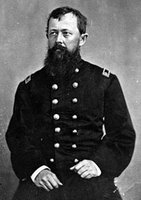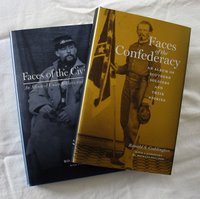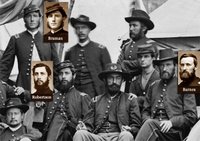The idea “that Americans came to fight the Civil War in the midst of a wider cultural world that sent them messages about death that made it easier to kill and be killed” is an argument worthy of study, and Mark S. Schantz explores the topic in detail in his new book,
Awaiting the Heavenly Country: The Civil War and America’s Culture of Death. Schantz examines key factors, organized in a series of essays, to support the argument, including
Uncle Tom’s Cabin and other books, memorial lithographs and writings, and postmortem photographs of the antebellum period.
I found the detailed descriptions of the materials interesting, and am certain that Americans were much influenced by the culture of death. However, I am not convinced it made it easier for the soldiers who went to war to kill, or for the veteran generals that sent them to their deaths to do so with an easy conscience. The thought that the constant reminder of death that surrounded their lives, be it by the loss of a family member to disease, the passing of a young wife due to complications of childbirth, or the untimely death of a young soldier on a battlefield, somehow enabled soldiers to take lives with tacit permission runs countercurrent to the argument.
The general impression left through my own research, having read by now thousands of pages of soldier letters and documentation in military service and pension files, suggests that the violence and wholesale slaughter witnessed by and participated in by soldiers on both sides left deep psychological trauma — known today as post traumatic stress disorder — that the medical establishment during the decades following the end of the rebellion were not organized to recognize and treat in a meaningful way.
Also, I’ve read several collections of letters, all following a similar arc: In the beginning of the war, the soldier has an idyllic view of military life and thinks in terms of a romantic adventure. Over his term of enlistment, the perspective changes as the realities of campaigning, battles, disagreements with generalship and government policy, and regimental politics sets in. Yet underlining this arc is genuine patriotism: Whether it is the spring of 1861 or the summer of 1864, love of country and commitment to the end the conflict remains steadfast on both sides.
I recently spoke by telephone with Betty Schacher. Her great uncle, Simon Pincus, served with distinction in the Sixty-sixth New York Infantry. One of the stories she told me was how her “Uncle Sime” let a Southern soldier go at Gettysburg. He said he couldn’t shoot him because they were all Americans. In this case, it appears patriotism came before death.
Schantz does not mention the peace movement that broke out throughout the North, the result of many factors, including the shock of long casualty lists. This suggests that citizens were repelled by the massive death tolls.
For these reasons, I argue that the culture of death in which they lived reinforced the fragility of life. I cannot imagine the great frustration and hopelessness that so many families struggled with as they helplessly watched children sink into death from disease, or the life of a desperately wounded soldier slowly ebb away. Their own powerlessness stands in stark contrast to today’s society, in which so many physical and mental problems are treatable or able to be successfully managed.
Without question the men and women of the nineteenth century lived in a culture pervaded by death. Yet they also lived in a culture of life, and that culture dominates.
I recommend you give this book a read. I found it to be thought provoking.
Labels: antebellum. schantz, civil war, country, culture, death, heavenly, history, social


